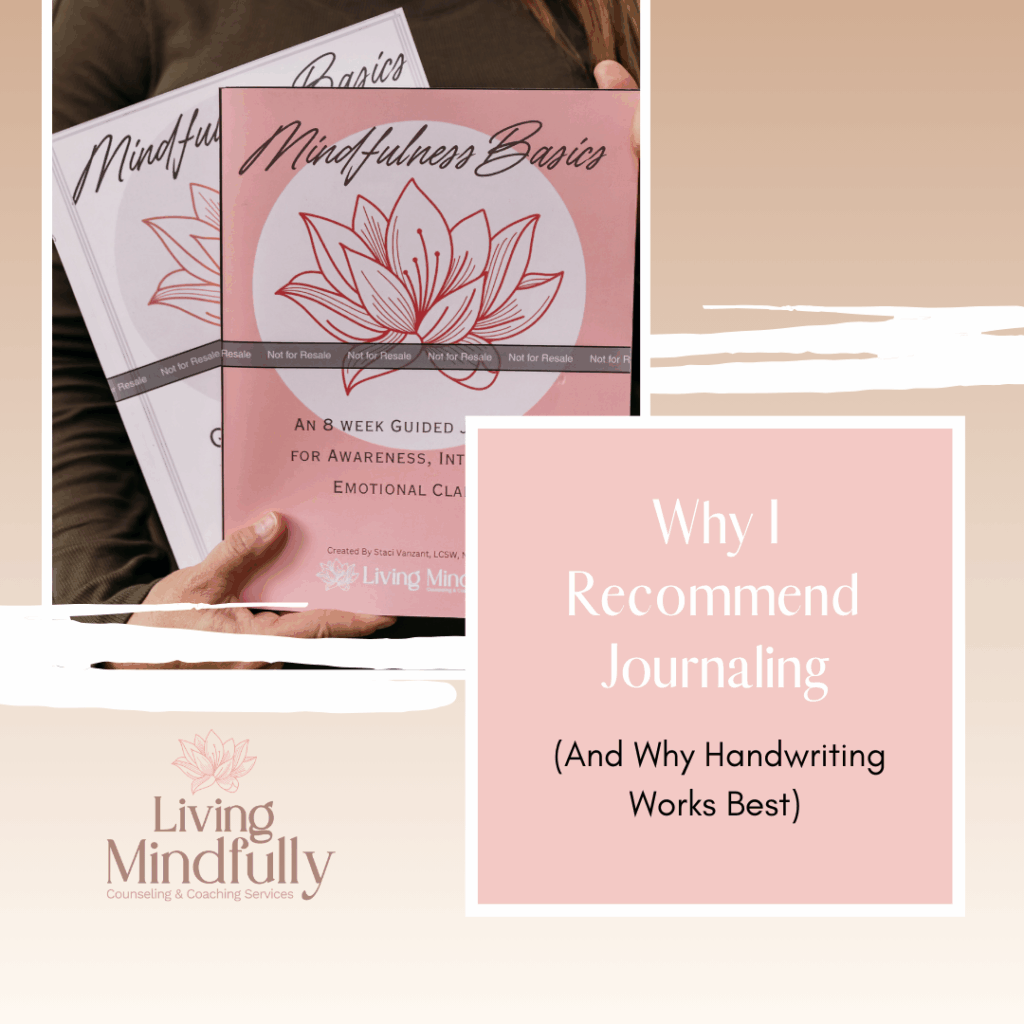
Why I Recommend Journaling (And Why Handwriting Works Best)
If change begins with awareness, journaling is one of the most reliable ways to build it. Putting thoughts on paper helps you notice patterns, clarify needs, and make intentional choices. Which is exactly the foundation we work on in therapy and coaching.
What the research says
1) Expressive writing supports mental and physical well-being.
Multiple meta-analyses and reviews of “expressive writing” (brief, structured writing about thoughts and feelings) show small but reliable benefits across mood, stress markers, immune functioning, and overall functioning. Effects aren’t magic or instant, but they are real and meaningful—especially when writing is guided and repeated over time. BPB+1
Nuance matters: a 2007 meta-analysis found minimal effects when protocols weren’t well targeted—another reason to use a guided format with prompts and a clear focus. PMC (This is why I created one for you! 😉)
2) Handwriting engages the brain differently than typing or dictation.
High-density EEG work shows that handwriting produces richer, more widespread neural connectivity than typing—particularly in networks tied to attention and memory encoding. In other words, the act of forming letters by hand seems to “wake up” more of the brain systems that help us learn and remember what we write. PMC+1 (Guys, this article has such a cool diagram that illustrates this…you should check it out!)
3) Handwriting strengthens learning and conceptual understanding.
In learning contexts, students who took notes by hand outperformed laptop note-takers on conceptual questions—likely because handwriting encourages processing and summarizing rather than verbatim transcription. That deeper processing is exactly what you want in a reflective practice like journaling. PubMed+1 (Again why I created one for you! 😉)
4) Handwriting helps build recognition and meaning from the ground up (even in kids).
fMRI studies show that printing letters by hand activates the “reading circuit” and other perceptual-motor regions more than typing or tracing. This sensorimotor engagement appears to enhance visual recognition and memory for symbols—a principle that likely carries into adults as we write complex ideas, values, and plans. PMC+1
Bottom line: typing and audio notes are useful, but when the goal is self-awareness, meaning-making, and lasting change, handwriting gives you a measurable cognitive edge.
Why journaling accelerates change
-
Self-awareness → behavior choice. Seeing your thoughts on paper creates distance from them; distance creates options. That’s the first step of change. (Supported by the expressive-writing literature above.) BPB+1
-
Emotion regulation. Labeling emotions in writing reduces limbic arousal and makes space for regulation skills you already know, like breathwork, grounding, and values-based actions. PMC
-
Cognitive clarity. Handwriting promotes deeper encoding and synthesis, which helps you connect dots (“Oh! That’s why I’m exhausted by Thursdays!”) and design realistic plans. PubMed
-
Motivation & follow-through. Brief, repeated sessions (10–15 minutes, 3–4 days/week) show better outcomes than marathon write-ups. Structured prompts focus your attention on what actually moves the needle. BPB
How to get started (and actually keep going)
-
Choose your container. A simple notebook is fine—but a guided journal reduces decision fatigue and keeps you focused on what matters (mood, triggers, needs, values, wins).
-
Keep it short and regular. 10–15 minutes, 3–5 days/week. Consistency beats intensity. (This mirrors the protocols in the expressive-writing research.) BPB
-
Use prompts that build awareness and action.
-
Regulate: “What am I feeling in my body? What helps me settle 5% right now?”
-
Reconnect: “What value do I want to honor today (family, health, presence)? One small way to live it?”
-
Restore: “What boundary or micro-recharge do I need in the next 24 hours?”
-
-
Handwrite first, digitize later (optional). If you like searchable notes, snap a photo or dictate a 1-sentence summary into your phone after you handwrite. You’ll get the encoding benefits of pen-and-paper and the convenience of digital.
Where my guided tools fit
-
The “Mindfulness Basics” Guided Journal gives you focused prompts that scaffold awareness → insight → action. It’s designed around brief daily entries and weekly reflections so you don’t have to figure out “what to write.”
-
The 12-Week Mindful Reconnection Solution takes journaling further: each week we pair targeted prompts with skills practice (Regulate • Reconnect • Restore) and coaching/therapy support. That structure addresses what meta-analyses suggest: guided, repeated writing with clear aims works better than occasional, unfocused venting. BPB
Here’s a One-Week Journaling Practice Plan:
*Didn’t get thru it all in the first week? No problem! Use what you didn’t get thru for next week! (Remember the goal to start is 2-3x per week…drop perfection!)
-
Mon: Body & breath check-in (2–3 sensations), name the top feeling, one regulating step.
-
Tue: Trigger → thought → feeling → action chain; identify a gentler reframe.
-
Wed: Values micro-goal (one action that honors a value today).
-
Thu: Boundary script (one sentence you’ll use).
-
Fri: Wins & lessons (two of each).
-
Weekend (optional): 10-minute free write + 3-line summary.
References (select)
-
Frattaroli, J. (2006). Experimental disclosure and its moderators: A meta-analysis. Psychological Bulletin. Positive, significant overall effect for expressive writing with moderators identified. BPB
-
Niles, A. N., et al. (2013). Effects of Expressive Writing on Psychological and… Review summarizing benefits and typical effect sizes. PMC
-
Meads, C., & Nouwen, A. (2007). Health effects of expressive writing… A critical meta-analysis noting minimal effects when poorly targeted—underscores value of guided protocols. PMC
-
Mueller, P. A., & Oppenheimer, D. M. (2014). The Pen Is Mightier Than the Keyboard. Psychological Science. Longhand note-takers showed better conceptual learning than laptop users. PubMed+1
-
Van der Weel, F. R., & Van der Meer, A. L. H. (2024). Handwriting but not typewriting leads to widespread brain connectivity: a high-density EEG study. Frontiers in Psychology. Handwriting produced broader neural coherence than typing. PMC+1
-
James, K. H., & Engelhardt, L. (2012). The effects of handwriting experience on functional brain development in pre-literate children. fMRI evidence that handwriting recruits reading-related brain regions more than typing/tracing. PMC
-
Longcamp, M., et al. (2008). Learning through hand- or typewriting influences visual recognition of new graphic shapes. Journal of Cognitive Neuroscience. Behavioral + fMRI evidence for handwriting advantages in symbol learning. PubMed

Staci Vanzant
LCSW, NBC-HWC
